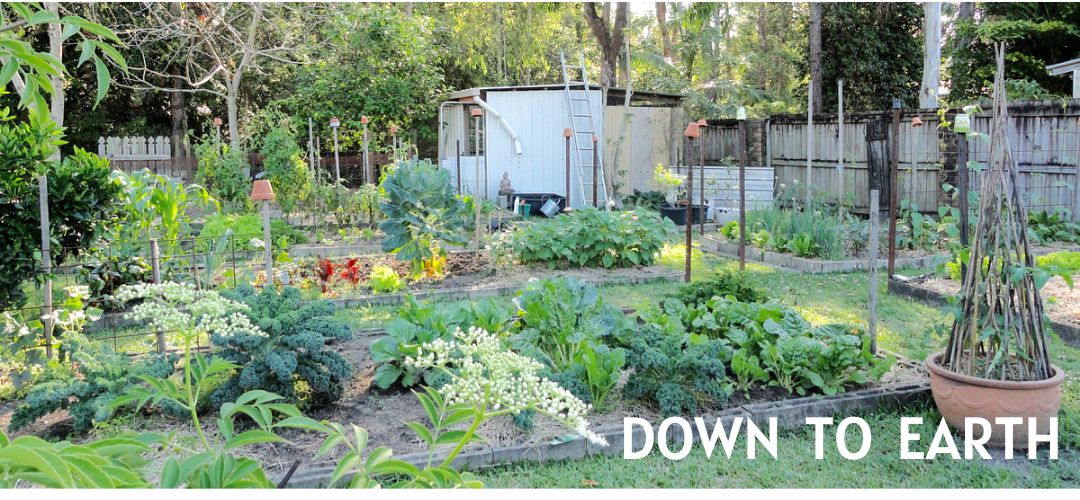When you're an organic gardener, it pays you to work in with the natural ecosystem in your backyard. Try to stay away from sprays, because even the organic options sometimes kill beneficial insects and have withholding periods. There will be times when you'll have to use a commercial organic spray, bait or powder, but make sure it's the last option. I don't think that every recommended organic methods works. For instance, over the 30+ years we've been growing vegetables, I've tried companion planting every so often, but it's never worked for us. However, there are other organic techniques that do work and we rely on them year after year.
Marigolds alongside bok choy, tomatoes and cucumbers.
One of the things we do here is to plant flowers in the vegetable garden. Almost any flower will be suitable because most flowers bring in the bees, but there are a group of flowers that attract beneficial insects. Not all bugs are bad and if you go around killing every insect you see, you will be doing completely the wrong thing. Some bugs eat other bugs, or their eggs, and some of them lay their eggs in the bodies of other insects. It sounds pretty gruesome but it's how the natural world works and it can help you.
Yarrow flowers - this plant is also good for activating compost.
Dill flowers
Please be aware that the insects in each country may be different. Some will be the same everywhere, but others specific to certain countries or regions. In Australia, these insects are always a pest: the European wasp - these are aggressive and dangerous; ticks - the paralysis tick can kill dogs and cats; mosquitos - carry disease; the large earth bumble see - these were accidentally released in Tasmania and have been an environmental disaster, completing with native bees for food; fire ants - a relatively new pest but a serious threat in the areas they've colonised.
These are the beneficial bugs: most bees - in Australia there are two solitary native bees: the teddy bear bee and blue banded bee, and our little native bee, the sugar bag bee. We also have the honeybee, introduced into Australia in 1822 because the English thought there were no bees here. All those bees are good and if you have bees visiting your garden, particularly the native bees, you're very lucky. There are photos here showing some of our bees, including the pest large earth bumble bee. Ants are sometimes good and sometimes not. If they start farming scale for the honeydew, find the nest and get rid of them. Predatory wasps, hoverflies and most ladybugs are good fellows. You can see photos of these bugs here. It's a good idea to learn how to identify the beneficial bugs. For the American and Canadian gardeners, here is a site for you. Again, learn how to identify these insects. They will help you produce all those vegetables you want. For my UK friends, here is a site for you. Other insects that you want in your garden include:
- assassin bugs
- lacewings
- stink beetles
- parasitic wasps and predator wasps like paper wasps and mud daubers
- many spiders
- dragonflies
- praying mantises
- robber flies
- lady beetles, but not the 28 spot beetle that looks like a lady beetle - they eat plants Photo here
- ant lions
If you have children, you'll have to be careful if you have wasps visiting. Our rule of thumb here is that if they start building a nest close to where we are, such as the one the paper wasps started building on our front verandah last year, we remove the nest. Otherwise, they stay. If you see the occasional wasps in your garden, it is nothing to worry about, it's a healthy sign. Predatory and parasitic wasps are not aggressive and will only sting if you disturb their nest or attack them.
Flowering lettuce also help attract insects.
If you're going to create a garden and be outside in the sunshine you have to expect to come across other living creatures. Don't be scared of them. Like us, they're a part of the beautiful natural scheme of things and have a role to play in our world. If you're a new gardener, do some online research to educate yourself about what to expect in your region. Work with the natural elements, not against them and you'll be rewarded.
Nasturtiums and yarrow.
Now you know what bugs you want in your garden, how do you get them there. Flowers! The insects will come if you plant the flowers they love. Beneficial flowers include:
- Cosmos
- Daisies, including echinacea, feverfew, chrysanthemums, gerberas and chamomile
- Red clover
- Queen Anne's Lace
- Carrot flowers
- Dill flowers
- Marigolds
- Alyssum
- Nasturtiums
- Yarrow
Most insects need water, so put out a small container, off the ground, full of pebbles or stones so the insects can land and leave the water safely. It would be best placed in a protected area, like under a tree, or close to some herbs. They'll need some pebbles to land on so they don't drown. That would be an excellent project for the children. It would get them involved in the garden and it could be their job to refill the water container, keep it clean and make sure there is the right amount of water and pebbles.
Gardening, particularly organic gardening, is not just planting seeds and watering; it's more involved than that. It's all these little things that make the difference between a garden and a productive healthy garden. And the thing about gardening is you learn something new every year, you never know it all, but even in those first few years, it gives rewards and pleasures that will bring you back year after year.







